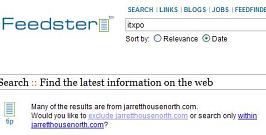The keynote interview with Dr. Eric Schmidt, CEO of Google, was as interesting for what he didn’t reveal as what he said. Eric has a bracingly dry sense of humor about his business and the industry, but he is deadly serious about the company and its responsibilities and challenges. He is also skilled at the art of offering insightful answers that do not directly answer the questions he is asked, so be forewarned as you read my notes. (Unless noted, everything below that is not a question is a paraphrase or direct quote of Eric.)
Q:Has the Internet leveled the playing field such that the dominant players in the industry can’t exercise their power? A:You know, “dominant” has a specific legal meaning…
There have been a lot of changes in the industry over the last 10-15 years. Back then, email was something you had to get in the car and drive to the office to do. I’d drop my daughter off, go to the office, do email, finish email and then hop in the car and go home…
(On how Google solves the performance and responsiveness issues that other companies might face online:) The problems are easier for Google because our data tends to be more static and lends itself to being replicated, as opposed to transaction based data that changes frequently.
(On Google’s internal systems🙂 When I got to Google we were going to build our own financial system because we were frustrated with the limitations of Intuit’s Quickbooks and its five-user license. Seriously. So I said that isn’t going to work exceptionally well when it comes to Sarbanes Oxley and auditing. We implemented Oracle Financials and put it in a box, and said “we aren’t going to change this.” Then we built a system around it to manage the business’s contact with it and we change that frequently.
Our focus is on personalization and comprehensiveness. For instance, you can see Google internet search results, your intranet (with the Google search appliance), and your hard drive all in one results list. Of course that brings in the issue of privacy, and that is where the “don’t be evil” corporate culture comes in. …Anyone can pull the ripcord and say “that’s evil” from an end user perspective and stop the train. [And no, Dave, I didn’t get a chance to ask him about autolinking, and he didn’t volunteer an opinion.]
We’re not in the information technology business, we’re in the information business. We have only digitized a very small percentage of all available content. There is a lot of room in the market.
(On advertising🙂 We don’t run the business as an advertising business. We run it based on end user satisfaction. If we keep our users satisfied, we keep our ad inventory up, which keeps advertisers happy. Q: You’ve taken away ad revenue from magazines and other traditional content players…. A: I prefer to think we’ve grown the market. There is a growing shift to more contextual ads and we are playing in that market. Q: You also seem to be important to a very large base of very small companies…. AIt is scary to understand that you are fundamentally in the revenue chain of a small business. We disseminate that information across the company and use it in planning products.
Q: You hired the lead developer of Firefox. Are you going to build a browser? A: We decided a long time ago that we would pursue a browser independence strategy, so that our services would work well on all browsers. These people, like the one you mentioned, are working on that, and do important work with the open source community as well.


